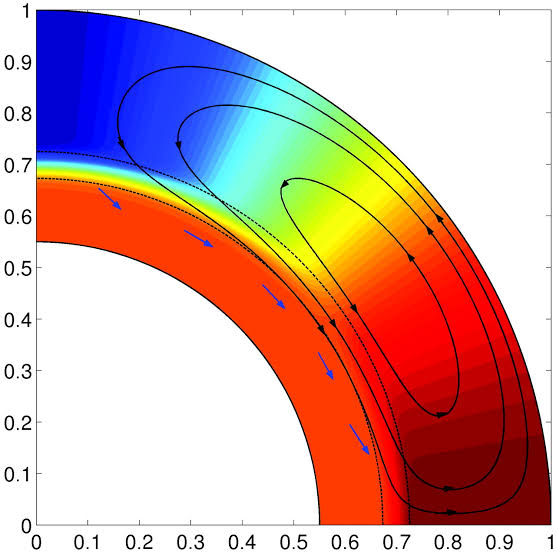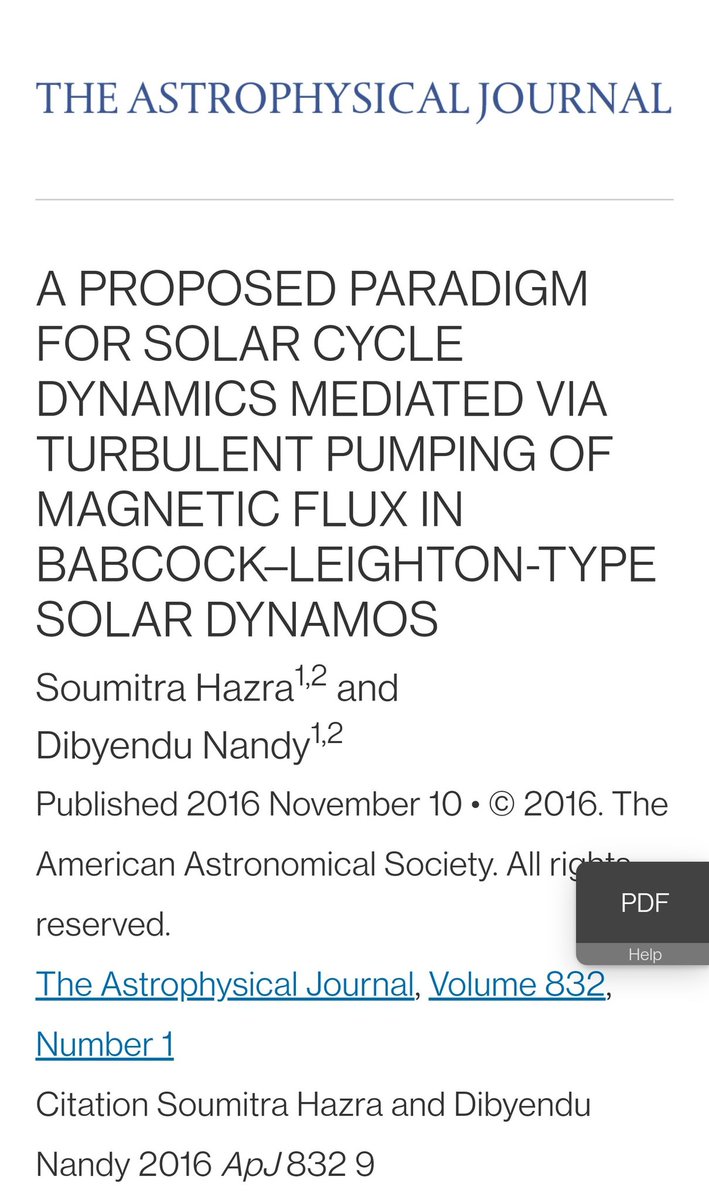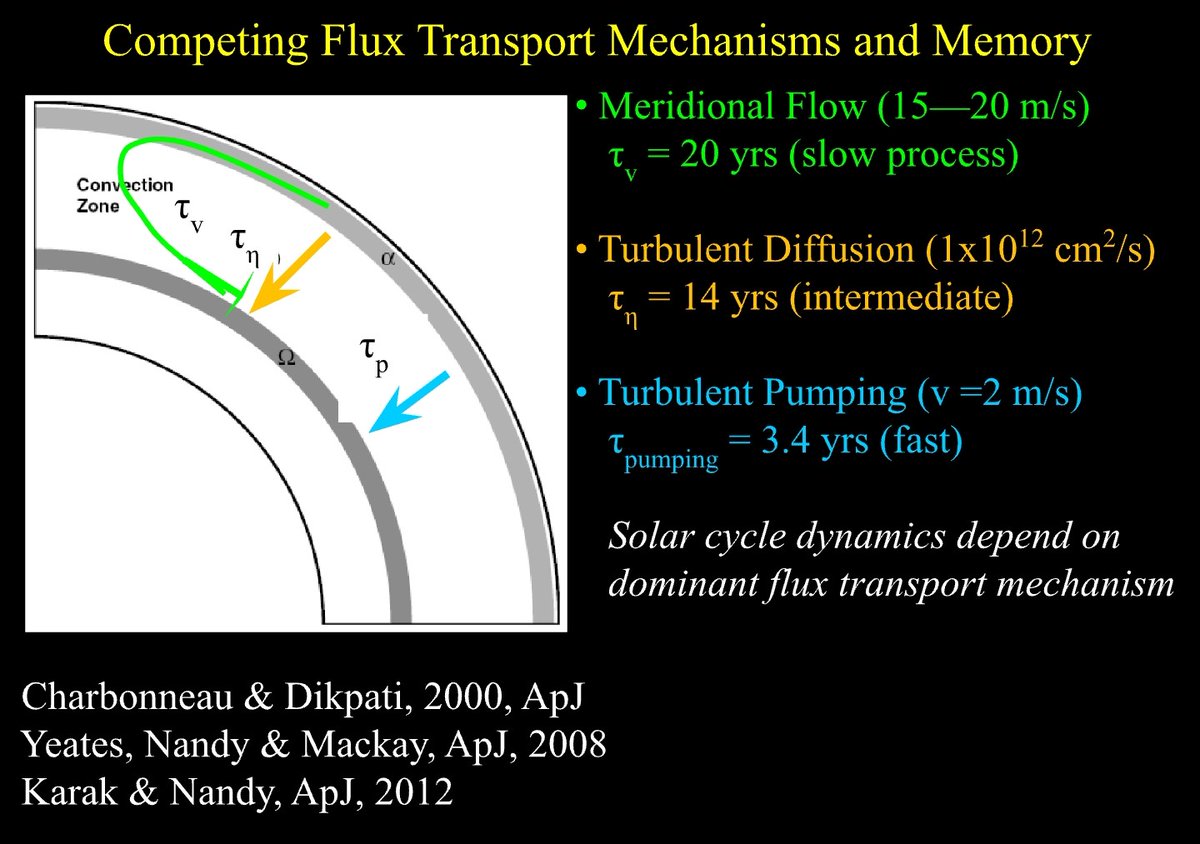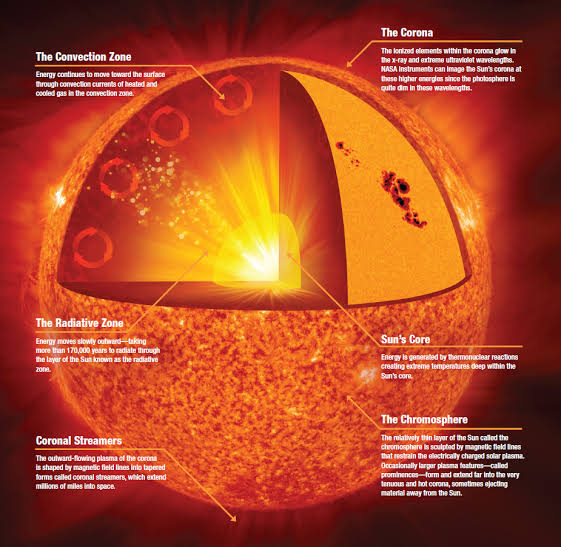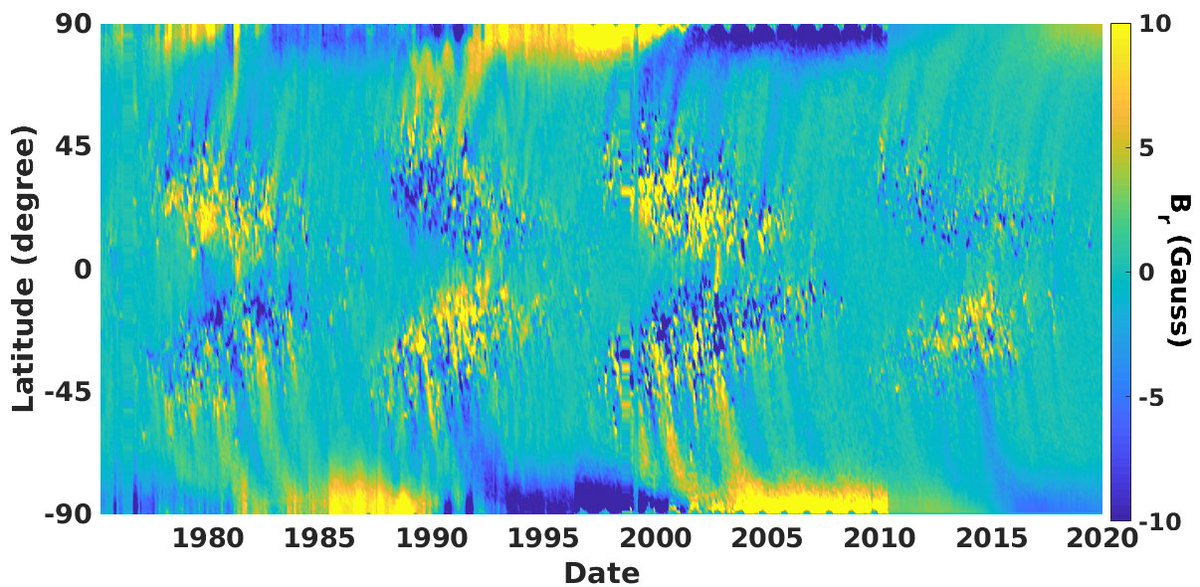"Why is the solar cycle 11 years long" someone asked @Dr_Lucie. You got a tough one! Here's my take on this in two parts. The first part is a non-technical answer and the second part is a deeper dive in to the solar dynamo mechanism that generates the 11 year #SunspotCycle 1/n https://twitter.com/Dr_Lucie/status/1361683422373175297
Non-technical answer: The magnetic field belt of #Sun that forms #sunspots is produced in its interior and propagates from high latitudes to the Sun's equator. The speed of the moving field belt makes it reach equator in 11 years during which sunspots pop out 2/n
This creates the 11 year sunspot cycle. Once the field belt reaches the equator, it is destroyed by another field belt of opposite sign which has been moving towards the equator as well in a synchronous manner. This results in the lovely (time-latitude) #SolarButterflyDiagram 3/n
Technical answer: There are multiple subtleties in the solar dynamo that together conspire to make a sunspot cycle 11 years and a full magnetic cycle 22 years long. Steve has already talked of some of these. Shall post more here with the caveat that we don't know everything 4/n
The magnetic field of rotating objects such as stars have two main components - the poloidal and toroidal components (the latter is in the direction of rotation and forms sunspots). The #solardynamo involves recycling of these two components. 5/n
https://svs.gsfc.nasa.gov/3521
https://svs.gsfc.nasa.gov/3521
Toroidal field migration from towards equator which takes 11 years sets sunspot cycle period. As @StevenTobias7 pointed out one theory is this migration is the result of a "conveyor belt" type transport by the Sun's internal meridional flow of plasma.
6/n
https://science.sciencemag.org/content/296/5573/1671
6/n
https://science.sciencemag.org/content/296/5573/1671
The above scenario is to some extent supported by observations of a one cell meridional plasma flow in the solar interior; the observed flow speed also is in keeping with the 11 year sunspot cycle and 22 year old magnetic cycle (the flow loop closes in about 20-22 years) 7/n
However there is skepticism among some on whether the weak meridional flow can efficiently transport the strong toroidal field belt which can quench the plasma flow through non-linear feedback (think Lorentz forces), thus rendering it ineffective 8/n
An alternative hypothesis is that the sign of the shear in rotation (differential rotation) in the Sun's interior and the sign of the dynamo alpha effect combine together to determine direction and speed of toroidal field belt migration (and hence sunspot cycle timescale) 9/n
This hypothesis, once popular, has run in to some difficulties because the observed sign of rotational shear at sunspot latitudes and the (necessary) positive sign of the dynamo alpha effect generates toroidal field migration in the opposite direction (towards poles)!
10/n
10/n
Turbulent pumping with the right properties may be able to generate solar cycle like equatorward migration of the toroidal field belts, circumventing the need or role of meridional circulation. But this is just another hypothesis. 11/n
https://iopscience.iop.org/article/10.3847/0004-637X/832/1/9/meta
https://iopscience.iop.org/article/10.3847/0004-637X/832/1/9/meta
In summary, the meridional plasma flow speed and direction in the Sun's interior are leading mechanisms for explaining the 11 year #SolarCycle period and sunspot migration towards equator (with some uncertainties, and alternatives not ruled out) 12/n
But wait! Have we solved only half the problem? Does a 11 year sunspot cycle guarantee a 22 year magnetic cycle  Not kidding. What if two sunspot cycles are 11 year each but there is a long gap between them so we have > 22 year magnetic cycle? 13/n
Not kidding. What if two sunspot cycles are 11 year each but there is a long gap between them so we have > 22 year magnetic cycle? 13/n
 Not kidding. What if two sunspot cycles are 11 year each but there is a long gap between them so we have > 22 year magnetic cycle? 13/n
Not kidding. What if two sunspot cycles are 11 year each but there is a long gap between them so we have > 22 year magnetic cycle? 13/n
This is not theoretically impossible. But observations indicate this is not the case - a complete magnetic cycle (thus two successive sunspot cycles) are usually around 11 x 2 = 22 years indicating spacing between cycles very short. 14/n
Is that understood? My claim is yes. I argue that spacing between two successive sunspot cycles is related to the speed of the fastest mechanism that can transport the old cycle poloidal field to the solar interior where the next cycle toroidal field is generated 15/n
There are two mechanisms, namely turbulent pumping and turbulent #diffusion of magnetic fields which are faster processes than meridional circulation and can bring down poloidal field produced during a cycle to the toroidal field production site within that cycle itself 16/n
So before a cycle (say N) ends the poloidal field of cycle N has already been brought down wirhin the shear layer in Sun's convection zone where generation of next cycle N+1 begins. So cycle N+1 is almost ready to go when cycle N ends. See simulations 17/n
https://svs.gsfc.nasa.gov/3521
https://svs.gsfc.nasa.gov/3521
Thus minimum time between two successive 11 year sunspot cycles and a 22 year magnetic cycle is a combined consequence of various plasma flux transpot processes such as meridional flow, turbulent diffusion and turbulent pumping in the Sun's interrior. 18/n
Of course there could be longer gaps between cycles, sometimes there are overlapping cycles, sometimes cycles are a bit shorter or longer than 11 years. The #SolarDynamo action is happening in the Sun's turbulent convection zone where fluctuations are natural in the output 19/n
Nonetheless, if you are still with me, please #AcademicTwitter #AcademicChatter give this thread a DOI so we can refer to this #TwitterPaper  ... hopefully I have been able to give you some idea of why is the #SolarCycle 11 years, and a solar magnetic cycle 22 years long 20/n
... hopefully I have been able to give you some idea of why is the #SolarCycle 11 years, and a solar magnetic cycle 22 years long 20/n
 ... hopefully I have been able to give you some idea of why is the #SolarCycle 11 years, and a solar magnetic cycle 22 years long 20/n
... hopefully I have been able to give you some idea of why is the #SolarCycle 11 years, and a solar magnetic cycle 22 years long 20/n
Finally, I have not touched upon all subtleties, have glossed over some asoects and not pointed to every relevant work. For a good and freely accessible review on the solar dynamo, see below 21/n https://link.springer.com/article/10.1007/s41116-020-00025-6
And to complete the loop let's just end with tweet no. 22 of this #solarcycle thread  Just a lovely #SolarButterflyDiagram (from @LekshmiBiji thesis) which depicts the cycle of both toroidal (sunspots) and poloidal (polar radial field) components of the Sun's magnetic field 22/n
Just a lovely #SolarButterflyDiagram (from @LekshmiBiji thesis) which depicts the cycle of both toroidal (sunspots) and poloidal (polar radial field) components of the Sun's magnetic field 22/n
 Just a lovely #SolarButterflyDiagram (from @LekshmiBiji thesis) which depicts the cycle of both toroidal (sunspots) and poloidal (polar radial field) components of the Sun's magnetic field 22/n
Just a lovely #SolarButterflyDiagram (from @LekshmiBiji thesis) which depicts the cycle of both toroidal (sunspots) and poloidal (polar radial field) components of the Sun's magnetic field 22/n

 Read on Twitter
Read on Twitter
